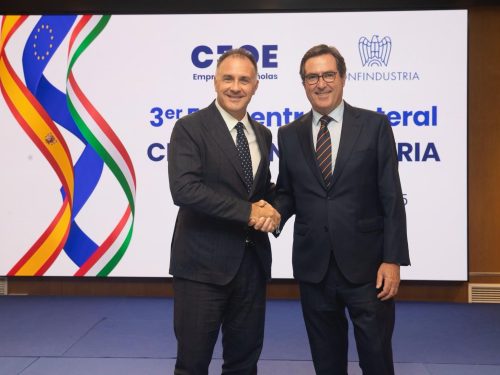Share on
Stagnation or restart? High uncertainty on Italian GDP in Q4, after the halt in Q3: on the one hand, confidence is low, industry in crisis, exports weak, the Eurozone sluggish; on the other, on the upside: the growth trend in tourism and services, the continuation of falling rates, low inflation, the implementation of the NRP. Cyclical factors are pushing upwards, but some structural obstacles are holding back.
Rates fall but France's spread rises. After official rate cuts in recent months, the ECB (3.25%) this week and the Fed (4.75%) next week are expected by the markets to make further cuts. In Europe, the sovereign rate in France is on the rise reflecting political instability and rising debt, and the spread over the German Bund (+0.75 in December from +0.65 in September) has risen above that in Spain (+0.64 from +0.76), which is narrowing as well as in Italy (+1.02 from +1.27) and Greece (+1.26 from +1.50).
Lower inflation. In November, inflation in Italy rose to +1.4% per year, closer to the core measure (+1.9%), as energy prices fell less (-5.5%). Similar trajectories in the Eurozone, but on values above the ECB threshold: total at +2.3%, slightly below core (+2.7%), energy decline almost over (-1.9%). This is due to the price of gas in Europe, which rose to EUR 44/MWh in November (+2.7% year-on-year) and in December is at EUR 47, dragging electricity prices upwards as well; the price of oil, on the other hand, at USD 74 in November, is still falling in annual terms (-10.4%).
Services driven by tourism. The driver of services remains the tourism of foreigners in Italy, which continues to expand (+6.9% annual expenditure in September). Discordant, however, are the indications for the 4th: in October RTT (CSC-TeamSystem) indicates an increase in services turnover, but in November the PMI slipped into the contraction zone (49.2 from 52.4) and business confidence was eroded in October-November.
Industry in crisis. In October, production remained unchanged, but continued to show a strong trend decline (-3.6%), deep for automotive (-34.5%), leather goods (-17.2%), and refined petroleum products (-15.8%). In terms of turnover, RTT reported a positive rebound in October. In November, business confidence halted its decline, but the manufacturing PMI fell even further (44.5 from 46.9).
Reducing investments. In November, business confidence continued to fall (IESI at 93.1, down from 95.5 in September) and demand, as measured by goods orders, remained low despite recovering from October's low (-22 the balance). This anticipates weak investment also in Q4 (-1.2% in Q3).
Volatile consumption. Household consumption in Q3 rose well above expectations (+1.4%), thanks to various positive factors: rising incomes, lower inflation, cheaper credit. Conversely, indications for Q4 are weak: household confidence fell in October-November (96.6, 1.2 points below the average for Q3); in October, car registrations fell for the sixth month (-0.8%) and retail sales experienced a sharp downward correction (-0.8%) after the September jump.
Weak exports. Italian goods exports, after three consecutive quarterly declines (-0.2% in volume in Q3), remained weak in Q4. Non-EU sales decreased in October (-3.5% in value), due to the slowdown in the US market and the fall in exports to China (-21.3% year-on-year in the first ten months). The outlook is still very uncertain, according to foreign manufacturing orders in October-November: weighed down by weak European demand and the announced new US protectionist measures. Negative indications for world trade from the foreign orders PMI, which has been in the contraction zone for the last six months.
Eurozone still sluggish. Although confidence indicators remained low, they denoted a certain stability in expectations in the area: sentiment on the economy, after growing moderately in Q3 (+0.3%), declined slightly in the first two months of Q4 (-0.2%); on the other hand, employment expectations, after falling in Q3 (-1.6%), returned to positive territory in Q4 (+0.4%). However, manufacturing continued to decline (PMI at 45.2 from 46.0) and services also contracted slightly (48.3 from 50.0).
USA: weak industrial activity. Industrial production also opened Q4 on a downward trend (-0.3% in October) and economic indicators signalled further weakness in November: the Chicago index fell to 40.2 points from 41.6, the ISM (48.5) and the manufacturing PMI (49.7) remained (slightly) recessive. On the other hand, the good trend in employment (+227 thousand) continues to fuel consumption, which remains the engine of the US economy at this stage: +0.4% retail sales in October.
China grows. Industrial production accelerated in November, driven by new orders (marking the highest growth in three and a half years) and by the rebuilding of inventories, reflecting increased confidence in the outlook. The government made public its commitment to boost domestic demand and stabilise the stock and property markets, also through unconventional policies: the first step was to change the monetary policy from 'prudent' to 'moderately accommodative'.
Tourism: towards new growth records in Italy
Growing travel by foreigners... In September 2024, the expansion of foreign tourism continued: +6.9% over 2023 expenditure in Italy at current prices; prices explain about half of this expansion (+3.4% trend in November for 'accommodation and food services'). This expenditure far exceeded pre-pandemic values (+28.8% in September on 2019).
...but those of Italians are declining. In the first nine months of 2024, total tourist arrivals in Italy decreased slightly compared to 2023 (-2.4%). This is due to the decrease in the domestic component (-6.5%), reflecting the weak dynamics of domestic consumption. By numbers, Italian tourists are worth only 47% of the total in 2024, 4 points down from 51% in 2019.
Total tourism expenditure increases. Total tourism expenditure in Italy, i.e. of Italians and foreigners in the country, is nevertheless estimated to increase, to 110 billion euro in 2024, from 108 in 2023 (100 in 2022). In 2024 the increase comes only from foreigners. In particular, the 'average expenditure per tourist' in Italy grows (+6.2% at current prices), estimated by comparing the dynamics of foreign presences (+0.8% tendential in September, measured on the 'number of nights') with that of the corresponding travel expenditure.
Tourism crucial for the Italian economy. Tourism is a sector with a high 'multiplier': for every EUR 100 billion of expenditure, EUR 255 billion is generated in terms of GDP; a large part of this is in the accommodation and catering sectors, but also in manufacturing, which acts as an 'induced' sector. According to ISTAT estimates, the direct and indirect weight of tourism in Italy comes to approximately 11% of the national added value (and 12% of employment).
Italy rises in the world rankings. In the rankings on international tourism, Italy is among the few countries in the top 10 (along with Turkey and the United Kingdom) to gain positions both in terms of tourist arrivals and receipts, compared to pre-pandemic times. Between 2019 and 2023, Italy climbs one position in the rankings by number of foreign tourists, surpassing China and gaining 4th place after the United States (at 1st place France remains stable); and also in the rankings by international tourist expenditure, surpassing the United Kingdom and gaining 5th place, immediately after France (here the top step of the podium remains firmly in the hands of the USA).
Accommodation services at the highest... Turnover in accommodation services is doing better than total services: already a record in 2023, it is continuing to grow this year (+3.9% in 2024 at current prices, the change acquired in September, compared to +0.6% for total services), although it is showing signs of slowing down in volume (-1.5% for accommodation, -0.2% for total services). By comparison, industry turnover recorded a negative change in September in both value (-4.6%) and volume (-3.5%).
...and highly utilised accommodation capacity. Capacity utilisation of accommodation establishments has now surpassed pre-pandemic levels: 51.5% in 2023 compared to 49.0% in 2019 (it was still 48.3% in 2022). The 10-year upgrading of hotel establishments continues: more beds in 5-star and luxury hotels (+13% in 2023 compared to 2022) and in 4-star hotels (+2.8%), in response to the global trend of higher demand for luxury tourism. The use of digital technologies for the purchase of tourism services is also growing: according to Istat, the use of digital technology for booking accommodation, which has had a strong boost since the pandemic, will further consolidate in 2023; about 70% of bookings are made via the internet (compared to 58.4% in 2019 and 66.6% in 2022).
Prospects still good. The UN Tourism Confidence Index shows positive expectations for Q4 2024, albeit below the outlook for May-August. At the European level, optimism among hospitality businesses continues: according to the Booking 2024 Barometer, 65% of European hoteliers surveyed reported a solid performance. About half of the respondents also point to the emergence of new trends in the industry: booking earlier (probably to secure the best prices) and shorter stays.





















